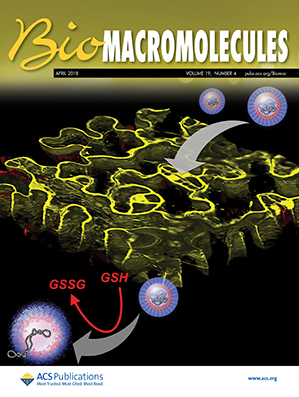含卟啉水溶性糖共聚物的合成及糖共聚物的物理性质及单线态产氧能力。
IF 5.4
2区 化学
Q1 BIOCHEMISTRY & MOLECULAR BIOLOGY
引用次数: 0
摘要
尽管光动力疗法(PDT)有望在选择性、更高的疗效和更少的副作用方面提供优势,但光敏剂在水介质中的低溶解度是一个重大问题。本研究以已知的四苯基卟啉[5-(4-氨基苯基)-10,15,20-(三苯基)卟啉](TPP)为原料,通过丙烯酰化合成了卟啉基单体。将卟啉单体和已知的糖基单体在丙烯酰胺存在下进行简单自由基聚合,以避免位阻,得到了相应的光敏剂聚合物,即具有卟啉部分的水溶性糖共聚物。卟啉核心的引入使聚合物具有荧光和活性氧生成的特性,d-乳糖和n -乙酰-d-氨基葡萄糖的加入分别显著提高了聚合物在水中的溶解度。该共聚物在可见光范围内具有较高的光吸收、发射和激发,并且在水溶液中具有卟啉单线态氧(SO)生成的特性,表明TPP加入到线状聚合物中。这些糖共聚物不仅在PDT领域有很好的应用前景,而且在抗癌方面也有很好的应用前景。本文章由计算机程序翻译,如有差异,请以英文原文为准。
Synthesis of Water-Soluble Glycopolymers Bearing Porphyrin by Means of Glycopolymer Assembly and Physical Properties of Glycopolymers Including Ability for Singlet Oxygen Production
Although photodynamic therapy (PDT) is expected to offer advantages in terms of selectivity, increased efficacy, and reduced side effects, the low solubilities of photosensitizers in aqueous media are significant issues. In this study, porphyrin-based monomers were synthesized by acryloylation of known tetraphenylporphyrin [5-(4-aminophenyl)-10,15,20-(triphenyl)porphyrin] (TPP). Simple radical polymerization of the porphyrin monomer and known glycosyl monomers in the presence of acrylamide to avoid steric hindrance yielded the corresponding polymeric photosensitizers, water-soluble glycopolymers with porphyrin moieties. The introduction of a porphyrin core gave polymer fluorescence and reactive oxygen species generation properties, and the addition of d-lactose and N-acetyl-d-glucosamine, respectively, remarkably improved solubility in water. The glycopolymers had high optical absorption, emission, and excitation in the visible light range and a singlet oxygen (SO) generation characteristic of porphyrins in aqueous solution, suggesting incorporation of the TPP into the linear polymer. The glycopolymers are promising not only for PDT but also as anticancer agents.
- Download: Download high-res image (100KB)
- Download: Download full-size image
求助全文
通过发布文献求助,成功后即可免费获取论文全文。
去求助
来源期刊

Biomacromolecules
化学-高分子科学
CiteScore
10.60
自引率
4.80%
发文量
417
审稿时长
1.6 months
期刊介绍:
Biomacromolecules is a leading forum for the dissemination of cutting-edge research at the interface of polymer science and biology. Submissions to Biomacromolecules should contain strong elements of innovation in terms of macromolecular design, synthesis and characterization, or in the application of polymer materials to biology and medicine.
Topics covered by Biomacromolecules include, but are not exclusively limited to: sustainable polymers, polymers based on natural and renewable resources, degradable polymers, polymer conjugates, polymeric drugs, polymers in biocatalysis, biomacromolecular assembly, biomimetic polymers, polymer-biomineral hybrids, biomimetic-polymer processing, polymer recycling, bioactive polymer surfaces, original polymer design for biomedical applications such as immunotherapy, drug delivery, gene delivery, antimicrobial applications, diagnostic imaging and biosensing, polymers in tissue engineering and regenerative medicine, polymeric scaffolds and hydrogels for cell culture and delivery.
 求助内容:
求助内容: 应助结果提醒方式:
应助结果提醒方式:


